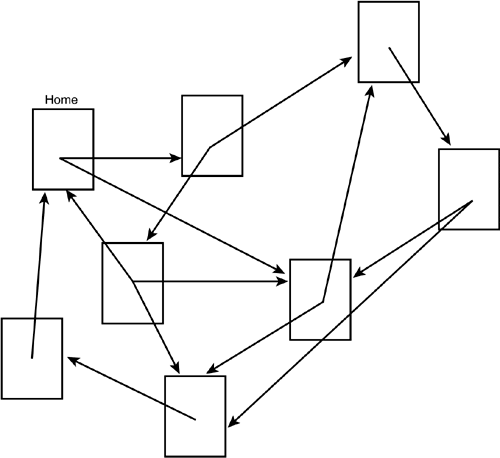| Finally, before you dive into creating Web pages, you must give some thought to the following issues: -
How can my message be broken down into an organized series of topics? -
How long of a Web page, or how many Web pages (linked together into a Web site), are required in order to say what I have to say?  After you've developed and refined the topic breakdown and outline of your message, you might find that you've already composed the headings for your Web pages. | Jot down a list of the topics or subtopics your document will cover. How many do you have, and how much material is required for each topic? After this simple exercise, you begin to get a good sense of the size and scope of your document. Now look at the topics. Do they proceed in a logical order from beginning to end, with each new part depending on knowledge of the earlier parts ? Or, does the material seem to branch naturally to subtopics (and sub-subtopics)? How might you reorder the topics to make the flow more logical or group related topics together? As you work on your breakdown (not that kind of breakdown ”your topic breakdown), a simple outline begins to emerge. The more you refine the outline before you begin composing your document, the more focused and efficient your authoring becomes. More important, the resulting Web document presents your message in a way that's clear and easy to follow.  To plan a document with three or more pages, storyboard it by roughing out each page on a piece of paper to decide which information belongs on each page. Tape the papers to a wall and draw lines or tape strings to plan links among the pages. | While you're building your outline, consider the logical organization of your presentation and how its material might fit into any of the common organizational structures seen on the Web: -
Billboard ” A single, simple page, usually describing a person, small business, or simple product. Most personal home pages are this type. They often contain links to related (or favorite) resources on the Web, but not to any further pages of the same document. -
One-page linear ” One Web page, short or long, designed to be read more or less from top to bottom. Rules are often used to divide up this type of page into virtual "pages." Readers can scroll through the entire page, but a table of contents and targets can be used to help readers jump down quickly to any section. This type is best used for fairly short documents (fewer than 10 screens full) wherein all the information flows naturally from a beginning to an end. -
Multipage linear ” The same general idea as the one-page linear type, but broken up into multiple pages that flow logically, one after the other, from beginning to end, like the pages of a story. You can lead the reader through the series by placing a link at the bottom of each page, leading to the next page. -
Hierarchical ” The classic Web structure. A top page (sometimes confusingly called a home page ) contains links to other pages, each covering a major subject area. Each of those pages can have multiple links to still more pages, breaking the subject down further and getting into even more specific information. The result is a tree structure, like the one shown in Figure 17.10. Figure 17.10. A hierarchical structure.  -
Web ” As shown in Figure 17.11, a hierarchical structure without the hierarchy. In this multipage document, any page can have a link leading to any other page. It might be a "top" page, but from there, readers can wander around the Web in no particular path . Web structures are loose and free- flowing and are, therefore, best suited to fun, recreational subjects or to subjects that defy any kind of sequential or hierarchical breakdown. (Hint: Before you resort to using a Web structure, make sure that your message really calls for one ”you might just be having trouble focusing.) Figure 17.11. A Web structure.  You can organize information in other ways; variations on each of the structures presented here. But one of these structures should resemble the general shape of your message, and thus your document. To put it another way, if you haven't yet decided which of these structures is best for the Web page you want to create, you need to play with your message some more and break it down in different ways until a structure reveals itself to you. |

